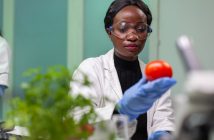The United Nations Food and Agriculture Organization estimates that nearly 800 million people in the world suffer from chronic starvation. While food technology has been strongly associated with the production of sweets, snacks, and processed foods, this technical field has also been important in the development of solutions to tackle world hunger. Here are some cutting-edge examples of how food technology can potentially solve the issues of malnutrition and hunger the world over.
Ready-to-Use Therapeutic Food
Severe acute malnutrition (SAM) is a life threatening condition that affects nearly 16 million young children around the world. These children at nine times more likely to die compared to nourished children. To combat this global malnutrition epidemic, ready-to-use therapeutic foods (RUTF) were developed to provide in-home nutritional therapy using low-cost, low-moisture materials. Using peanuts as a protein and lipid base, RUTFs contain vitamins and minerals, sugars, and other protein additives such as whey or milk powder for a complete amino acid composition. RUTFs are designed to be easily digestible, be nutrient dense, maintain a long shelf-life from the low-moisture content, require no refrigeration, and packaged for ease of transport and storage. Several organizations compete for supply contracts with UNICEF, including MANA Nutrition, Valid Nutrition, and Nutriset, which supplies the highly successful Plumpy’Nut.
Protein Reactor
Researchers from a joint study between Lappeenranta University of Technology (LUT) and VTT Technical Research Centre of Finland have found a way to produce synthetic protein using electricity from renewable resources. The process involves applying an electric current through a mixture of water, carbon dioxide, and microorganisms. After two weeks, the bioreactor produces a gram of crude food containing 50 percent protein, 25 percent carbohydrates, and 25 percent lipids and nucleic acids. Since the process is continuous and independent of environmental conditions that can affect farm-based methods of food production, it can be used to help feed people suffering from famines and starvation. While still in its early development stages, the goal of the project is to produce environmentally sustainable food with greater energy efficiency than current farming practices.
Food Powder
According to the Food and Agriculture Organization of the United Nations, one third of all food produced in the world is lost or wasted, with fruits and vegetables suffering the highest wastage of all foods. FoPo Food Powder is the brain child of an international team from Lund University. The startup collects low-cost fruits and vegetables near their expiration from farms, and transform them through spray-drying into a shelf-stable product that can last up to two years. In powder form, the product can be easily transported while still retaining the nutritional content of the original produce. The team recently competed and won the Thought for Food Challenge, and completed a successful fundraising campaign through Kickstarter.
Cricket Farming
Entomophagy, or insect eating, is becoming a hot trend as a sustainable solution for alleviating world hunger. In 2013, the United Nations Food and Agricultural Organization wrote a report that showed insect-based foods contained high levels of essential nutrients, including a complete protein composition. Using this knowledge, start-up companies like Exo, Bitty Foods, Six Foods, Aspire and Entomo Farms are attempting to develop and supply cricket-based food products for human consumption. The main ingredient used in these products is cricket flour, which is a powdered protein derived from roast-dried crickets and combined with a regular flour for flow. However, one major challenge in the edible insect market includes changing the predominant food culture that views insect eating as a taboo. Additionally, technical knowledge on how cricket powder behaves in a food is still lacking, as the lipids in cricket powder produce off-flavors during storage.
Microalgae
With a growing population of people in the world, there will be a greater need for high-nutrient foods. A recent study was completed that suggests microalgae could be one of many potential solutions to the looming challenge of food abundance and sustainability. Microalgae boasts a high nutritional content, complete with omega-3 fatty acids and amino acids. For example, spirulina microalgae contains a protein content of 65% its total dry weight. Microalgae can be easily grown using carbon dioxide and sunlight in open ponds using either fresh or saltwater. Alternatively, they can be grown in photobioreactors, using LEDs as a source of light. These have the advantage of being stackable and independent of changing solar light, providing a way to scale food production vertically. However, new processes are needed to convert the microalgae into an edible product consumable by humans. And companies like Corbion (formerly TerraVia and Solazyme), are still facing technological issues when growing microalgae to scale, as well as food safety challenges with the recent backlash from consumers due to incidences of gastrointestinal distress when their algal flour was used in Soylent’s product.
Edible Drone
There is a large amount of resources involved with emergency food supply airdrops onto food-starved, inaccessible regions. The cost of an airdrop is estimated to be $1,000 per ton of food, which includes fuel, air transport, materials, crate packaging, and parachutes. To reduce this wastage, Nigel Gifford started Windhorse Aerospace to design the first disposable, edible drone to serve on missions for humanitarian aid. Called the Pouncer, the drone is largely constructed of food materials, with its main body and wings filled with a variety of foods. The remaining structure is made of wood, which can be used as a fuel for cooking and heat. However, the edible drone has received criticisms for its poor execution and lack of insight into the problems involved with humanitarian aid.
While none of these technologies will solve the world hunger crisis alone, they may each contribute in their own way to the growing challenge as the global population continues to rise.
______
Need to speak with a food technology expert? Consult Bryan Le for a freelance project here, or take a look at Kolabtree’s freelance food scientists.







